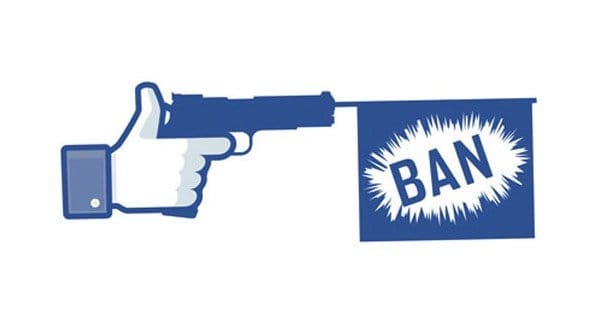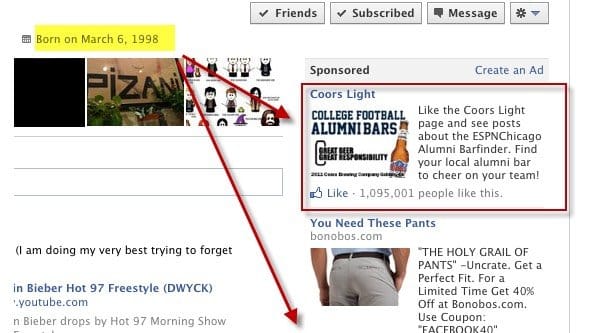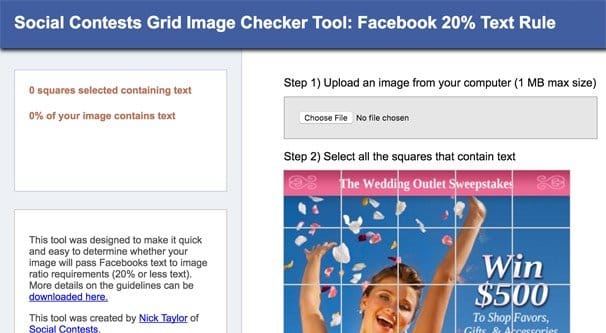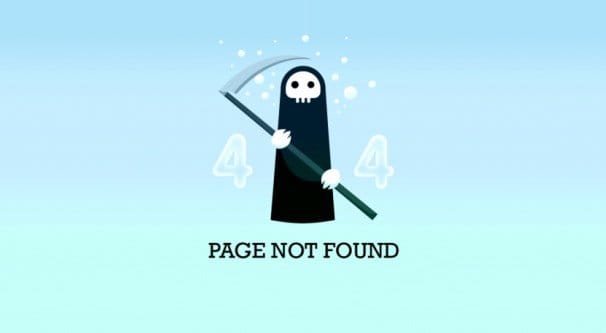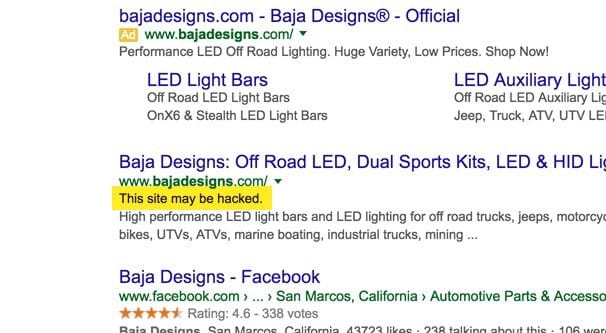 Written by ContentPowered.com
Written by ContentPowered.com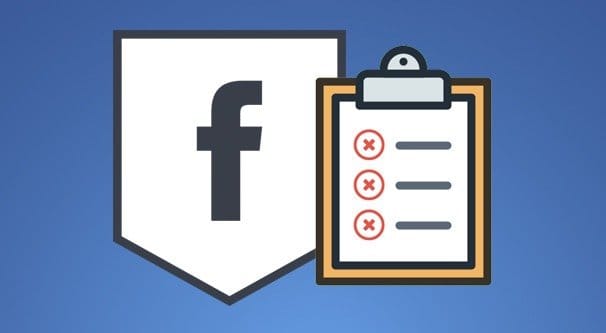
Facebook ads are a tricky system. There are a lot of draconian rules in place, mostly stemming from past methods of abuse or complaints Facebook gets. When enough ads are reported and they all share something in common, Facebook will ban whatever is causing the reports, and marketers simply have to adapt.
This leads to some illogical practices. The 20% text rule is somewhat infamous for being exactly this. Why should you be limited to only 20% of your image as text? More importantly, why is it regulated with a grid tool that means movements of text a handful of pixels up will suddenly make an image okay? It’s a problem that grew out of past abuse and has been left in an illogical place.
It’s particularly annoying when your ads are rejected but you have very little idea of why. Sure, Facebook will tell you in general what’s wrong, but it doesn’t help much when the reason for rejection is “violation of the ad guidelines” or something equally vague.
There’s only so much you can do to keep within those guidelines. You can follow all of them you’re aware of, you can follow an ad template to make something positively attractive, and you can optimize your audience, copy and image to hell and back. It doesn’t matter if Facebook decides to take issue with some minor quality of one of your ads and blocks the whole campaign. Just look at the list of rules you have to keep in mind for every ad!
1. Make Sure You’re Not Advertising Prohibited Content
Facebook has a lot of rules about the kinds of content you can promote and the kinds of images you can use to promote it.
I’ll go ahead and summarize them here, but you can read more about them in the ad guidelines that I linked above.
- You cannot promote anything that is illegal, be it a product, service, or activity. That means no illegal drugs, no unsafe supplements like black salve, no explosives, and so forth.
- You cannot promote anything that is restricted on Facebook. That means no tobacco products, no adult products or services, and no weapons, legal or otherwise.
- You cannot promote anything using sexual imagery. Sex may sell, but not on Facebook.
- You cannot use images that are disturbing or shocking, or have an otherwise negative response in viewers. No pictures of car crashes, no guns pointed at the viewer, and other such direct references to violence.
- You cannot use “before and after” comparison images, regardless of whether or not you’re promoting a product or service that produces results.
- You cannot promote dating sites, benign or adult rated, without permission from Facebook.
- You cannot promote games of skill or real money gambling without permission from Facebook.
- You cannot promote a state lottery unless you are the official representative of that lottery in that state.
- You cannot promote online pharmacies, legal or otherwise.
- You cannot promote subscription services that include negative options, automatic renewals, or free trials that roll over into paid versions without opt-in.
2. Make Sure You’re Not Violating Age Targeting Rules
Facebook has age targeting rules for a number of different types of items you might want to promote.
Alcohol is simultaneously the biggest and most complicated example. It’s entirely allowed to promote alcohol via ads on Facebook. However, when you run ads – and when you create your page – you need to specify that you are an alcohol page and that you are promoting alcohol. This puts limitations on the targeting and ability for people to follow you. This is because alcohol restrictions vary from country to country. Rather than asking you to know the laws for each area you target, Facebook handles it invisibly and simply asks you to flag yourself appropriately.
Supplements are another example. Herbal supplements, dietary supplements, vitamins and other such non-medical supplements can be promoted – subject to Facebook’s review – but only to people who are above the age of 18.
If you happen to be one of the few lucky companies able to get a dating site partnership with Facebook, you will then be restricted to users above the legal age of consent as well, typically above the age of 18. Obviously, don’t try running ads or promoting your page to an audience you shouldn’t, unless you want your permission to be revoked.
Any other type of content that is not restricted or banned on Facebook entirely but has laws at a local, state, or federal level that regulate the age a user needs to be in order to obtain the content, will need to be restricted. I don’t know how tightly Facebook pays attention to county or city level laws, but I wouldn’t be surprised if they check when you run a highly geotargeted local ad.
3. Make Sure Your Image Complies With 20% Text Rules
I mentioned it already, but Facebook’s 20% text rule is pretty crazy. It’s a more or less automatic process that detects text and will block ads that have too much text, using a grid-based tool that can sometimes count half-letters and half-words as text in a grid. One single letter can be as much as a 5% different in text, so positioning becomes insanely important.
You can check an image yourself by using a simulated version of the grid tool here. Upload your image and the tool will overlay a grid. Click on each square that has text in it. If you have checked six or more boxes, you have more than 20% text on your image, and it’s very likely that your image will be rejected until you edit it. You will have to reposition your text so that it’s within five boxes.
If this seems like an oversimplification, prepare to have your mind blown; it’s not. This grid method is the exact method Facebook uses to determine text density on an image. It doesn’t matter if you have one large headline with three words taking up ten boxes, or 15 sentences in 10 point font taking up five; the amount of text, the size of it, and what you say matters very little. The positioning within those arbitrary boxes are what matters.
For a detailed example of the rule and how a simple change in positioning and size can make a huge difference, check out Jon Loomer’s rant/guide on the 20% text rule. It’s worth it, if for no other reason than to see how arbitrary the rule is. Heck, his logo – entirely text – doesn’t count as text.
4. Make Sure You’re Not Referencing People Directly
This is a line that Facebook draws when referencing personal information, and it’s there primarily to make Facebook seem less invasive, less creepy, and less prescient than they could be if they allowed you to use all of the data they harvest and you have. For example, you can target something as narrow as 23-year-old white males in Oklahoma City making more than 60,000 per year. That’s a relatively narrow demographic. That’s fine, if your ad says something like “Services for Rich White 20-Somethings.” On the other hand, if you were to run an ad that says “Hang Out With Other Rich White 20-Somethings” you’d be implying that the viewer specifically meets that demographic.
Even if they do, it’s against the rules of Facebook ads to imply that knowledge. This is partially so they can avoid instances where you’re implying something negative or racist, and partly to avoid the disconnect that happens when someone outside the demographic slips in.
Specifically, Facebook doesn’t allow you to imply or assert any personal attribute, including race, ethnicity, religion, beliefs, age, sexual or gender orientation, disability, any medical conditions, financial status, union membership, name, or criminal record. That’s quite the list! I’ve seen marketers go all-out with avoiding all of those topics in their copy, which is a safe way to go, through it does limit you a bit.
Facebook primarily wants to avoid having something like this happen again. While amusing and mostly harmless, it wasn’t a good PR moment for them, and they have since made some changes to limit the minimum audience to prevent it from happening again.
5. Make Sure Your Image Isn’t Imitating a Video
This is a specific issue with images, and while I say “imitating a video” it applies to any sort of implied functionality that doesn’t exist.
What do I mean? Well, have you ever seen one of those ads that looks like a video player, complete with a big play button in the middle? They crop up all over the place on niche video sites, in pop-unders, and on adult sites. They’re made to look like an attractive video, but when you click to play the video, you’re instead taken to a landing page you didn’t intend to visit.
This is what Facebook wants to avoid. The disconnect between “I’ll get to see a video” and not seeing a video is huge, and it drives people to disengage with the ads, report the ads, and trust the ads system less than they already do.
You can include buttons and the like in your ads, so long as the buttons – that is, the image link itself – actually work. For example, if you have a button that has a typical “click here for more details” call to action, that’s fine as long as the link to the landing page is a page where details can be had. You can’t imitate, say, a form where the user could fill in their email address, because the image is not a form and the user cannot input their data on the ad.
6. Make Sure You’re Not Using Another Company’s Trademarks
This one is a simple one. Don’t use the trademarks – logo, slogan, name – of any company you don’t own. I can’t run an ad for Coke, I can’t run an ad for Nike, and I can’t run an ad for Facebook. You’re allowed to use specific Facebook information in your ads, but they have a very specific set of rules about the use of their brand assets. Violating those will see your ad rejected as well.
7. Make Sure Your Landing Page Functions and is Relevant
When you submit an ad, make sure the landing page exists. You can’t create ads for a landing page you haven’t yet made or uploaded, unfortunately. This is because Facebook will check the destination of the URL to make sure it works and that it’s relevant to the content and copy of the ad.
If the page doesn’t exist, you’ll get a rejected ad. If the page does exist, but it’s not about what the ad is about, the ad may be rejected, though it’s not always the case.
8. Make Sure Your Image Isn’t Sexually Suggestive
Facebook has a very strict rein on the sort of sexually suggestive imagery that can be present in a Facebook ad. Anything involving genitalia or exposed sexual characteristics is right out. Anything involving intercourse is out. Anything implying impending intercourse is out. Anything picturing an adult toy or piece of suggestive equipment is out. Even just trying to use a woman in skimpy clothing is often grounds for rejection, though that depends somewhat on what specifically she’s wearing and what specifically you’re advertising. Advertising exercise equipment, lingerie, or supplements with a healthy looking woman in a bikini is probably fine. Using the same image to sell a lawnmower is not.
9. Make Sure Your Site Hasn’t Been Hacked or Serves Malware Ads
One of the things Facebook checks, in addition to the function and the context of the landing page when they review your site, is if the site is safe. Sometimes your ad may be rejected if they detect some malicious code on your page.
There are three primary reasons why this might trigger. The first is that you’re actively and maliciously trying to serve up malware. If so, stop it, go turn yourself in to Internet Prison, and see the error of your ways. The second is that you’re running ads that cycle through content provided by an ad network, and one of the ads in circulation is using an exploit to provide malware. Talk to your ad network and get that ad removed from circulation to fix the problem.
The third cause is if your site has been hacked and is providing malware to your viewers without your knowledge. It sucks to find out this way, but you’ll have to recover from the hacking and remove all malicious content before you can get your ads approved. That’s if you can at all; your site may have been added to a blacklist, which is virtually impossible to get out of.
10. Make Sure You Have Permission for Restricted Topics
If you’re trying to run a gambling site, dating site, or otherwise restricted content that is allowable with specific permission from Facebook, make sure you have that permission from Facebook. It’s going to be a big official process to get it, so you want to keep it on hand. For example, for dating sites, you will need to fill out this form if you want to have a chance at being approved. You need your name, email address, service name, parent company, link to the site or app, expected ad spend, and ad account ID. You also need a bunch of more free-form answers, like a description of the service, your role in the business, what other agencies you work with, the billing structure, and how users are matched. All of this allows Facebook to filter out exploitive or dangerous sites.
11. Make Sure You File An Appeal
If your ad has been rejected and you think you meet all the guidelines – and you know you meet the one they emailed you about – or if your ad has been rejected several times now, you can file an appeal. The form for the appeal is here and gives you information to input so you can choose the rejected ad and get it looked at more closely. This should be used as a last resort, or in cases where you suspect an automatic rejection and that it was in error.
